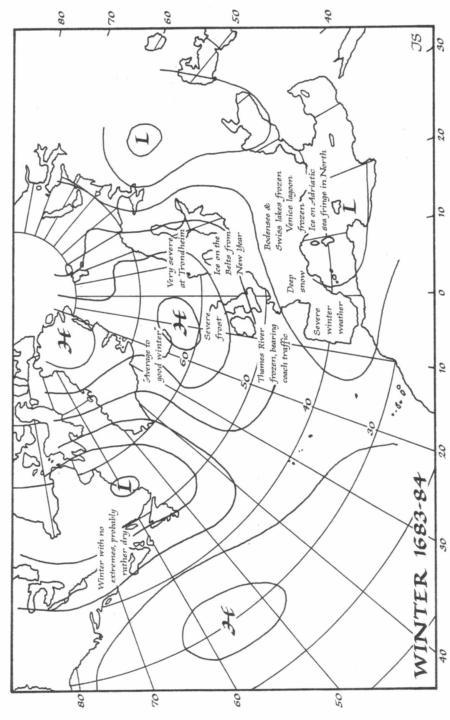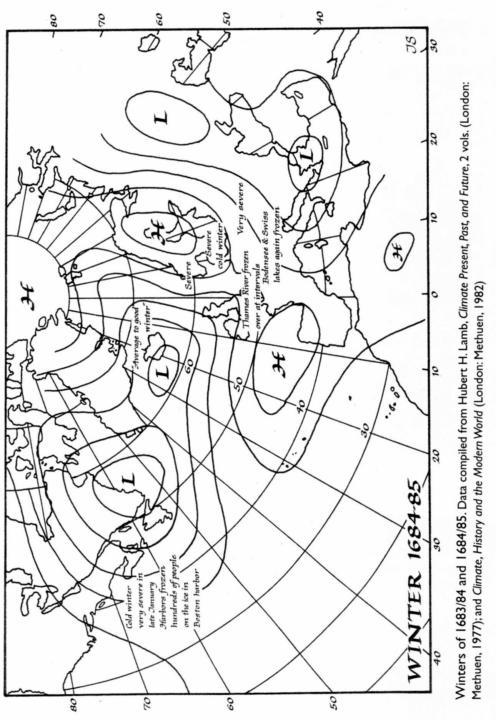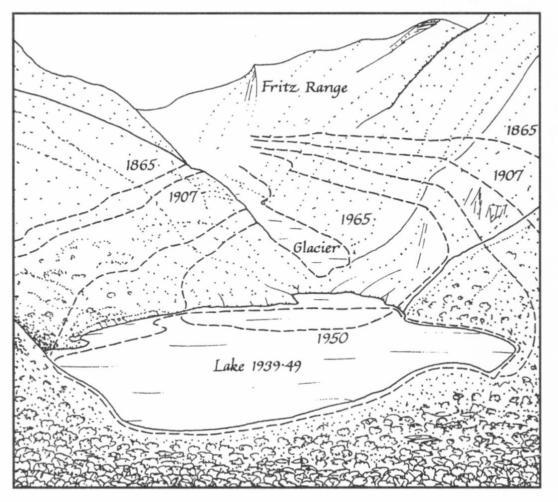The Little Ice Age: How Climate Made History 1300-1850 (22 page)
Read The Little Ice Age: How Climate Made History 1300-1850 Online
Authors: Brian Fagan

Potatoes prevent scurvy, provide quick and cheap meals for farm laborers
and their families, and require but the simplest of implements to plant and
harvest. Combined with milk or other dairy products, they made up a diet
that was far more complete nutritionally than the bread- and cereal-based
diets of sixteenth-century Europe. You would think that Europeans would
have embraced such a crop with immediate enthusiasm, but they did not.
Conquistadors regarded potatoes and the Andean Indians who grew
them with contempt. The potato was poor people's food, vastly inferior
to bread. Inevitably, strong social prejudice accompanied the few tubers
that came to Europe. After beginning their European career feeding patients in a Seville hospital for the poor in 1573, potatoes soon became a
botanical curiosity, even a luxury food, not a food for the indigent.
The new plant spread from garden to garden in the hands of ardent
botanists and their wealthy patrons. Potatoes appeared in the pages of
herbals, where readers learned that the Italians ate them "in a similar
fashion to truffles."15 In 1620, the English physician Tobias Venner
praised them in his Via Recta ad Vitam Longam ("The Right Road to a
Long Life") as "though somewhat windie, verie substantiall, good and
restorative." He recommended roasting them in embers, then dunking
them in wine. However cooked, "they are very pleasant to the taste and
doe wonderfully comfort, nourish and strengthen the bodie." Venner
prescribed them for the aged and remarked that the potato "incites to
Venus." 16 Despite these good reviews, many people thought them exotic
and poisonous. Potatoes were a root crop, not the kind of leafy plant
that could flavor or garnish roast meat. They occasionally appeared on royal menus as a seasonal food and were an expensive luxury. The English, not yet meat and potatoes folk, considered the potato an almost
indelicate plant that did not belong in the diet of a seventeenth-century
gentleman.
In 1662, a Mr. Buckland, a Somersetshire landowner, wrote to the
Royal Society of London arguing that potatoes might help protect the
country against famine. The Agriculture Committee of the Society
promptly agreed and urged its landowning Fellows to plant such a crop.
John Evelyn, the Society's gardening expert, wrote that potatoes would be
good insurance against a bad harvest year, if for nothing else than to feed
one's servants. In 1664, a pamphleteer named John Forster argued in a
book entitled England's Happiness Increased: A Sure and Easie Remedy
against the Succeeding Dearth Years that the potato was a sure remedy for
food shortages, especially when mixed with wheat flour. Deep-rooted social prejudices among the political and scientific elite prevented them
from setting an example and eating potato dishes. As for the poor, many
of them preferred to go hungry than to give up their bread.
French peasants resisted potatoes for generations. In bad years, they
made do with inferior or slightly moldy grain, suffered under ever higher
prices, became hungry, and often joined bread riots. The potato was still an
exotic food in France as late as 1750 and even then shunned by most gourmands. Burgundy farmers were forbidden to plant potatoes, as they were
said to cause leprosy, the white nodular tubers resembling the deformed
hands and feet of lepers. Denis Diderot wrote in his great Encyclopaedie
(1751-76): "This root, however one cooks it, is insipid and starchy.
... One blames, and with reason, the potato for its windiness; but what is a
question of wind to the virile organs of the peasant and the worker."17
In England, the potato was grown as animal fodder, then as food for
the poor, with flourishing potato markets in towns like Wigan in the
north by 1700. Across the Irish Sea, the Irish rapidly embraced the potato
as far more than a supplement. It was a potential solution to their food
shortages. Quite apart from other considerations, potatoes were far more
productive than oats, especially for poor people without money to pay a
miller to grind their grain. Soon the Irish poor depended on potatoes to
the virtual exclusion of anything else, a reliance that laid the foundations
for catastrophe.
The sun is only one of a multitude-a single star among millions-thousands of which, most likely, exceed him in brilliance. He is only a private in the host of heaven. But he alone
... is near enough to affect terrestrial affairs in any sensible degree, and his influence on them ... is more than mere control
and dominance.
-Charles Young, Old Farmers Almanac, 1766
 etween 1680 and 1730, the coldest cycle of the Little Ice Age, temperatures plummeted, the growing season in England was about five
etween 1680 and 1730, the coldest cycle of the Little Ice Age, temperatures plummeted, the growing season in England was about five
weeks shorter than it was during the twentieth century's warmest decades.
The number of days each winter with snow on the ground in Britain and
the Netherlands rose to between twenty and thirty, as opposed to two to
ten days through most of the twentieth century.' The winter of 1683/84
was so cold that the ground froze to a depth of more than a meter in parts
of southwestern England and belts of sea ice appeared along the coasts of
southeastern England and northern France. The ice lay thirty to forty
kilometers offshore along parts of the Dutch coast. Many harbors were so
choked with ice that shipping halted throughout the North Sea.
Conditions around Iceland were now exceptionally severe. Sea ice often blocked the Denmark Strait throughout the summer. In 1695, ice
surrounded the entire coast of Iceland for much of the year, halting all
ship traffic. The inshore cod fishery failed completely, partly because the fish may have moved offshore into slightly warmer water, but also because
of the islanders' primitive fishing technology and open boats. On several
occasions between 1695 and 1728, inhabitants of the Orkney Islands off
northern Scotland were startled to see an Inuit in his kayak paddling off
their coasts. On one memorable occasion, a kayaker came as far south as
the River Don near Aberdeen. These solitary Arctic hunters had probably
spent weeks marooned on large ice floes. As late as 1756, sea ice surrounded much of Iceland for as many as thirty weeks a year.


Cold sea temperatures brought enormous herring shoals southward
from off the Norwegian coast into the North Sea, for they prefer water
temperatures between 3 and 13°C. English and Dutch fishermen benefited from the herring surge, while the Norwegians suffered. This was
not the first time the fish had come south. In 1588, in a previous cold
snap, the great British geographer William Camden had remarked how
"These herrings, which in the times of our grandfathers swarmed only
about Norway, now in our times ... swim in great shoals round our
coasts every year."' The revived fisheries brought a measure of prosperity to Holland, as the country fought for independence, as did the development of simple windmills for draining low-lying fields. But repeated storms and sea surges overthrew many coastal defenses and
inundated agricultural land. In Norway, the shortened growing season
was even more marked than further south, at a time when mountain
glaciers were advancing everywhere. The Norwegians turned the cold
weather to their benefit. Many coastal villages abandoned their fields
and began building ships to export the timber from nearby forests. Between 1680 and 1720, Norway developed a major merchant fleet based
on the timber trade, transforming the economy of the southern part of
the country.
The cold polar water spread southward toward the British Isles. The
cod fishery off the Faeroe Islands failed completely, as the sea surface temperature of the surrounding ocean became 5'C cooler than today. Just as
it had in the I 580s, a steep thermal gradient developed between latitudes
50' and 61-65' north, which fostered occasional cyclonic wind storms
far stronger than those experienced in northern Europe today. The effects
of colder Little Ice Age climate were felt over enormous areas, not only of
Europe but the world.

The retreat of the San Josef Glacier, South Island, New Zealand,
1865-1965. The glacier face has retreated even farther since the 1960s.
Redrawn from New Zealand Government sources; see also jean Grove,
The Little Ice Age

